 2009
2009  September 2009
September 2009  Tank of the Month
Tank of the Month
Stats:
 | Today | 830 |
 | Yesterday | 5613 |
 | This week | 11551 |
 | Last week | 53781 |
 | This month | 830 |
 | Last month | 199251 |
 | All days | 33797279 |
Your IP: 18.191.136.109
Mozilla 5.0,
Today: Apr 01, 2025
Tank of the Month
Hu Haiwei's (Welles) Reef Aquarium |
 |
Introduction
It is so exciting for me that my tank was selected as Tank of the Month, and it is a great honor for me and my country since this is the first Chinese tank to be featured as Tank of the Month. I would like to thank the Reef Central team that has made my dream come true and given me a chance to share my story with reefkeepers all over the world.
My name is Hu Haiwei. I was born and raised in Beijing, China, and I started my first reef tank in 2003. It was difficult to find the knowledge and equipment needed for a reef tank in China at that time; only a few people knew the basic concepts of reefkeeping such as the use of live rock and the Berlin method, and I was not one of them. So, as per the recommendation from my LFS, I started out in the hobby using dead rocks, a very low flow rate in the tank and many ceramic rings in the sump with a small and weak skimmer. The result was terrible! Fortunately, we live in the age of the Internet, and I have learned a great deal from Reef Central and Reefkeeping Magazine, and was able to buy equipment from various websites such as Premium Aquatics. So, in the first two years I kept making modifications to the system, and finally, I learned how to provide proper nutrition to the inhabitants, how to keep calcium and alkalinity in control, and how to deal properly with lighting and flow. In 2006 I decided it was necessary to re-design the whole system to reach my dream—an SPS dominated tank. I then started my second reef tank, a 180-gallon lagoon style system focused primarily on SPS corals. In 2008 I built the present 250-gallon system and moved over most of the corals from the old tank. By the way, the modern concept for the reef aquarium is accepted by most hobbyists and vendors in China, so it was easier for me to build this third system.
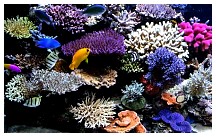 |
 |
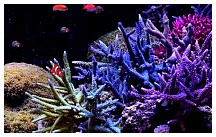 |
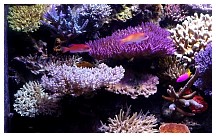 |
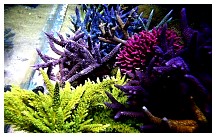 |
 |
Since the old 180-gallon tank was a shallow rimless tank, I wanted a different style tank with longer and deeper dimensions to try some new possibilities with aquascaping. The other objective for the new system was to make it as simple as possible, because I believed a simpler system would be more reliable. Hence, the whole system is pretty “traditional” in design, and I spent only one month in planning. Within another month, a local vendor called X-Tank built it for me.
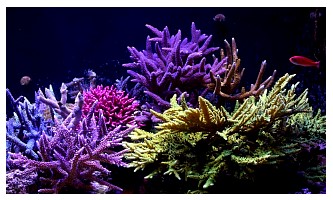 |
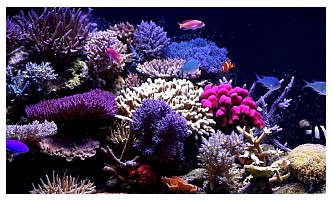 |
System Profile
The main display is made of low-iron glass; while it does not compare to acrylic tanks in transparency, it is easier to clean. The stand was made of wood using traditional Chinese furniture technology; the whole structure was joined by mortise and tenon joints without any nails or glue.
Profile:
Main Tank: ~210 gallons (80’’ x 28’’ x 28’’)
Sump: ~40 gallons (60’’ x 20’’ x 20’’)
Skimmer: Royal Exclusive Bubble King 300 internal
Return Pump: Atman MP6500 and LifeTech 9000
Water Movement: two Tunze Turbelle Stream 6101, one Tunze Turbelle Stream 6201, one Tunze Wavebox 6212, Tunze Multicontroller 7095, one EcoTech VorTech MP40W
Lighting (display): three 400-watt XM 10K lamps with an IceCap ballast, 300-watt VHO Super actinic, 144-watt DIY LED (a 3 watt CREE white and blue LED unit)
Lighting (refugium in sump): one 150-watt BLV 6500K metal halide
Cooling: 2HP chiller with titanium coil made by local vendor, four fans in canopy.
Calcium and alkalinity: two-part method with GroTech TEC III NG dosing pump
Other reactors: two Bubble-Magus mini reactors with KZ Biophos 2 Phosphate Absorber and Seachem’s Purigen
Controller: Neptune System AquaController 3
Misc: 5-stage RO/DI, DIY auto top-off system
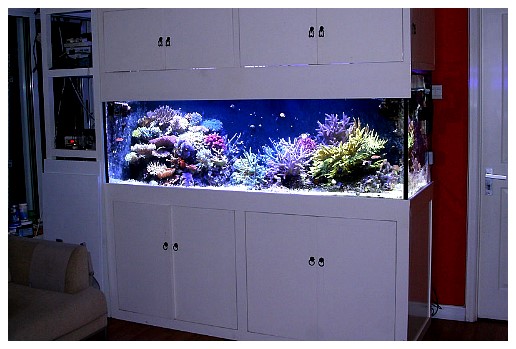 |
Lighting
|
Photoperiod:
|
My favorite lighting is XM 10K metal halides for their ultra high PAR value. I think the growth rate of corals is one of the most important factors to consider when aquascaping a reef aquarium, and I am very satisfied with XM 10K bulbs for producing outstanding growth. As for coloration, I generally like the natural look produced by the XM bulbs, but I would prefer if they had a little bit more blue in the mix. I have tried ReefLux 12K lamps, but they are too blue for me. When testing the ReefLux 12K and XM 10K, I found the mixed color of XM 10K and ReefLux 12K is ideal for my tastes. So, after running on “XM 10K only” for one year, I decided to add some blue supplements to the 10K metal halides.
I made a new DIY fixture body from aluminum and mounted three aluminum heat sinks positioned between the Lumenarc reflectors. On each heat sink I installed 16 CREE 3-watt LED bulbs (70% blue and 30% white). Beside the LED lights, I also added four 75-watt VHO Super Actinic for the added blue effect. The lights are controlled by a five channel timer; each metal halide lamp uses one channel, while the VHO bubs and LED lights use another two channels.
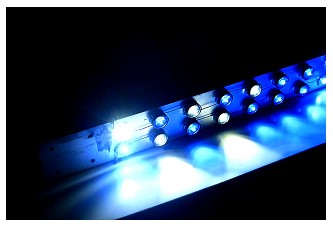 |
 |
Filtration and Equipment
The sump and plumbing of the system is very simple - the water from the main display drains through two 1.5” PVC pipes into the first section of the sump. Almost all of the filtration equipment is located in this section, including the skimmer, two reactors (filled with KZ Biophos 2 Phosphate Absorber and Seachem Purigen), activated carbon and the chiller’s titanium coil. The second section of the sump contains the refugium. Since it is difficult to find Cheatomorpha in China, I use Caulerpa serrulata instead. I also keep some Gracilaria sp. in the sump, which is used to feed the tangs. The two return pumps are located in a third section, and these two return pumps are powered by separate power lines to improve reliability.
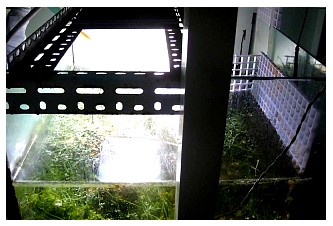 |
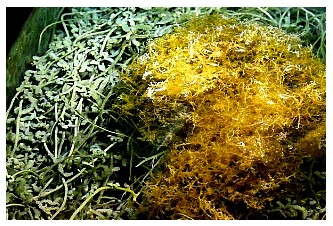 |
The first skimmer used for this system was a Bubble-Magus 360 (BM360) external skimmer, until I replaced it in May of 2009 with a Royal Exclusive Bubble King 300 internal model. The capability of these two skimmers is similar, but I wanted to reduce the heat produced by the pump as much as possible - the BM360 needed four pumps to run and it was little bit noisier than the BK300 internal model.
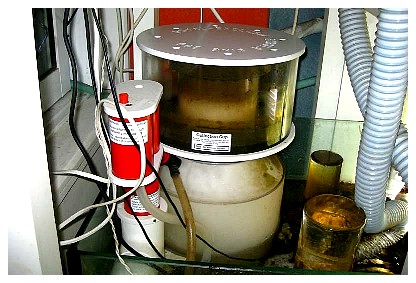 |
I have a Neptune System AquaController 3, but I am still waiting for the launching of the 220V version Direct Connect 8 power strips, so I am using it as just a monitor now. I especially like this controller for its Internet function and the iPhone application.
|
Water Parameters:
|
Calcium and Alkalinity
The calcium and alkalinity levels are kept up by a GroTech TEC III NG dosing pump using calcium chloride and sodium bicarbonate; the third channel of the dosing pump is used to dispense Tropic Marin’s Pro-Special mineral salt. I do not dose magnesium daily, but I will add some magnesium chloride when I do a water change. I do not know if I should call this method two-part or balling, but it is more convenient for me because it is very easy to buy high purity chemicals in China and very difficult to buy quality carbon dioxide bottles for a calcium reactor.
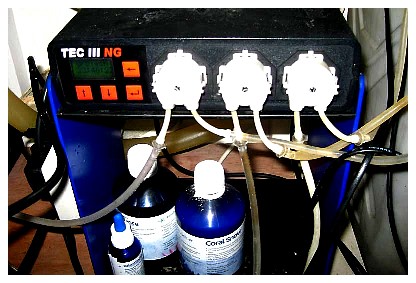 |
Cooling System
The temperature of Beijing typically rises over 100° F in summer, so a powerful chiller is a must have piece of equipment for the serious reefkeeper. I installed a 2HP chiller on the system to take the heat outside the house. There are four fans located in the tank’s canopy to cool the metal halides, and each heat sink of LED units has two CPU fans installed to allow the LEDs to run at a normal temperature.
Food and Additives
I feed the fish one or two times per day with different kinds of flake and pellets, and feed Ocean Nutrition Instant Baby Brine Shrimp, especially for the Anthias, several times per day. For the corals, I use various types of foods and additives, including KZ Coral Vitalizer, Pohl's Sponge Power, KZ Amino Acid, Xtra, Reef Chili and Coral Frenzy. I feed these foods and additives for the corals after the lights are off.If the nutrition in the water rises, nasty algae begin to appear, and I consequently reduce the feeding of the corals.
Maintenance
I change approximately 20% of the tank’s water using Instant Ocean salt every 10 days, clean the protein skimmer every few days and refill the two-part solution, if needed.
Livestock
There are about twenty fish in the tank, and most of them are relatively small. I have kept three large angelfish (an Imperator, Majestic and Regal angel) in the previous tank.While they have never nipped on corals, they need be feed often to keep them healthy. Finally ,the Bryopsis break out and the problem continue to this system, I have fight with Bryopsis for several month to eliminate it all, so I am very careful of large angel fish now, but they are still my target in future.
|
Fish:
|
Most of corals in the tank are SPS corals, with several LPS corals, soft corals and clams.I am not good at identifying corals, so I could not provide a thorough list of corals.
Future Plans
In the near future I am considering changing the display tank to an acrylic tank, and in the long run I am planning for a bigger tank, of course. I believe this is the future plan for most all reefkeepers. Besides upsizing the tank, I am working with some reefkeepers to build the first aquafarm in China called AMF Beijing (www.amfaqua.com), and I hope it will be helpful for both the hobby and the reefs.
Acknowledgments
Many thanks to the Reef Central community and Reefkeeping Magazine.You’ve provided great information to help many hobbyists all over the world, and taught me how I could succeed with a reef aquarium and the provided a path to get there.I would also like to thank all the friends in the China Marine Fish community (www.cmfish.com), especially some crazy reefkeepers in Beijing- only this group would be crazy enough to drive over 200 kilometers to another city to buy corals at midnight.Finally, I have to thank my wife’s support in putting up with my hobby and my endless plans for a bigger tank. The reef tank and the aquafarm have already become a great part of our life.
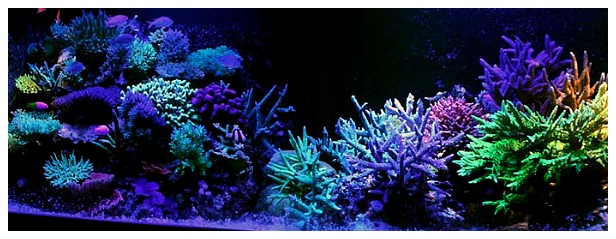 |
Full tank shot with only LEDs & VHOs.
Feel free to comment or ask questions about my tank in the Tank of the Month thread on Reef Central.




